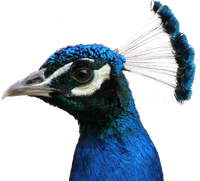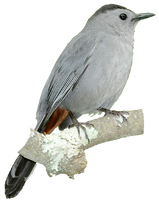Painted Buntings are fairly common birds inhabiting subtropical North America. These bright, colorful finches seem to have flown out of a children's coloring book.
Appearance
Painted Buntings are medium-sized finches with stubby, thick, seed-eating bills. Males are stunningly colored with blue heads, red underparts, and green backs. Females and immatures are a uniform, bright yellow-green overall, with a pale eyering. Though they are basically unpatterned, their overall color is greener and brighter than similar songbirds.
Painted Buntings are larger than an American Goldfinch and smaller than an Eastern Bluebird. They are 4.7-5.1 inches (12-13 centimeters) in length and weigh 0.5-0.7 ounces (13-19 grams).
Occurrence
Painted Buntings occur in southeastern United States along the Gulf of Mexico coasts, Mexico, Caribbean islands, and Central America. breed in semi-open habitats with scattered shrubs or trees. They are short- to medium-distance migrants, migrating at night. There are two breeding populations that have separate wintering grounds, though both move toward high grass, shrubby overgrown pasture, and thickets.
Life History
Diet
Painted Buntings eat seeds for most of the year. They forage on the ground for fallen seeds. They may fly up to grab a plant stem and drag it to the ground, holding it in place with one foot while eating the seeds. During the breeding season they catch a variety of arthropods. In addition to ground foraging, in the breeding season they also forage in marshes and in trees, sometimes over 30 feet off the ground. They may pull invertebrates from spiderwebs, or even dive straight through a web to steal a spider’s prey.
Nesting
Both parents search through dense foliage for nest sites. They usually choose a spot 3–6 feet off the ground but sometimes as high as 50 feet when there is no low vegetation, making sure there are with nearby perches and open feeding grounds. In as little as 2 days, the female builds a well-constructed nest that is firmly attached to a supporting plant. Forming an inner cup 2 inches wide and 1.5 inches deep, she weaves together some combination of soft plant material and sometimes tissue paper or rag scraps. She then binds the materials with cobwebs and sometimes lines the nest with horsehair.
Painted Buntings have 1-3 broods with 3-4 eggs in each per year. The eggs are grayish or pale bluish white, with fine speckles of brown and gray. They are 0.7-0.8 inches (1.8-2.1 centimeters) in length and have a width of 0.6 inches (1.4-1.5 centimeters). Incubation period is 11-12 days and nesting period is 9 days. At hatching, the hatchlings are helpless and nearly naked, with some light down, weighing less than a tenth of an ounce.
Behavior
Males vigorously defend territories of about 3 acres, fighting other males by striking each other with their wings. Their fights end with lost feathers, wounds, eye damage, and sometimes death. A male may also dive at and hit a flying female, driving her to the ground and pulling at her feathers.
When courting, however, the male goes to great lengths to please his potenial mate. Among other displays, he spreads his feathers like a miniature male turkey, while the female pecks at the ground. Painted Buntings are mostly monogamous, but occasionally two females will nest on one male’s territory.
Though severely territorial during the breeding season, Painted Buntings may form small flocks on the wintering grounds, often joining other seed-eating species.
Sounds
The Painted Bunting’s song is a series of short, musical phrases of thin, sweet, high-pitched notes lasting about 2 seconds. When establishing territories in the spring, a male may sing 9–10 songs per minute from several perches within his territory. Neighboring males often sing back and forth at each other, a territorial behavior called countersinging.
Painted Buntings give soft plik calls.
Conservation
Painted Buntings are still fairly common, but their populations have been declining for several decades due to habitat destruction and illegal pet trade.
Gallery
Trivia
- The western population of Painted Bunting molts during migration, which is common among waterfowl but very rare among songbirds.
- The French name of the Painted Bunting, nonpareil, means “without equal,” a reference to the bird’s dazzling plumage.
- In 1841 John James Audubon reported that “thousands” of the colorful birds were caught every spring and shipped from New Orleans to Europe, where they fetched more than 100 times the price when sold as cage birds. The illegal pet trade still continues in Mexico, Central America, the Caribbean, and less in Florida, despite efforts by conservationists to stop it.
- The oldest recorded wild Painted Bunting was at least 12 years old, as reported from a Florida banding study.
- Painted Buntings are also called Azulillo Sietecolores (in Spanish) and Passerin nonpareil (in French).
| Projects | ||||||
|---|---|---|---|---|---|---|
| ||||||






